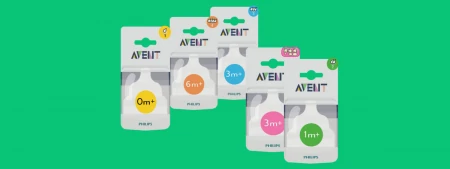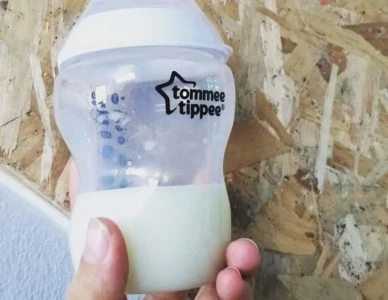Feeding your baby with the wrong Philips Avent nipple sizes can lead to an upset baby, an over-fed baby, or even increase the milk flow too much that it spills out your baby’s mouth. With six different nipple sizes, it can be confusing to know where to start.
When I was a new parent, I was naïve about the world of bottle nipples. I didn’t know they came in different flow sizes. I just figured they were all the same. But you need to get one that matches your baby’s stage of development. Since I’ve been there, I can help you find out which Philips Avent Nipple Sizes you should be using for your baby.
When you choose the right size, not only will your baby be happier and well-fed, but it will make weaning your baby off of breastmilk and onto bottles much easier since they will take to the Philips Avent nipple much easier.
Key Takeaways
- Choosing the right nipple size for Philips Avent bottles is crucial to ensure the baby is not upset, over-fed or has too much milk flow that spills out of their mouth. It is important to match the nipple size to the baby’s stage of development.
- The table below recommends different nipple sizes for different age groups, from 0-1 month preemies to 6+ months babies, and explains the importance of the flow rate of the nipple.
- If baby seems comfortable while feeding, don’t change sizes, but if baby seems frustrated and impatient during feedings, it’s time to experiment with a faster nipple flow.
Avent Nipple Sizes by Age
These are the Avent nipple sizes we recommend by each age group:
| Avent Nipple Size | Baby Age | Ideal For |
|---|---|---|
| First Flow Nipple | 0-1 Month | Preemies & Newborns |
| Newborn Nipple | 0-3 Months | Newborns (0-1M) & Breastfed Babies (0-3M) |
| Slow Flow Nipple | 1-3 Months | Newborns (1-3M) & Breastfed Babies (3M+) |
| Medium Flow Nipple | 3-6 Months | Babies (3M+) |
| Variable Flow Nipple | 3+ Months | Different Flow Rates with the Same Nipple |
| Fast Flow Nipple | 6+ Months | Babies (6M+) |
All age indications are approximate. “M” Refers to months. (1)
Can’t I Just Use One Size Nipple?
My son would get upset during his bottle time and I couldn’t figure out why. I knew he had to be hungry and I could see him sucking furiously on his bottle. But instead of being content, he just seemed mad.
It was only when I told my problem to another mom that I learned about nipple sizes. It was an awakening experience to learn the truth about nipple sizes, and I’d like to share that knowledge with other parents.
What I learned was that companies aren’t selling different nipple sizes just to earn more money – size does matter.
If the flow from the nipple is too slow, your baby will be cranky and frustrated. If the flow from the nipple is too fast, it will feel like Niagara Falls to your baby and milk will be spilling out of her mouth. Plus, if your baby is feeding too quickly, she may begin spitting up more than before (2).
The Philips Avent bottle offers a nipple size to meet every baby’s needs. Avent also has several other great features: it’s BPA-free, has a wide neck for easier cleaning, and an ergonomic design that makes it comfortable for both babies and parents to hold.
What Size Nipple Should I Use?
Here are the general guidelines (3):
- If your baby is both breastfed and bottle-fed, for the first month you should use the Newborn nipple that has one hole.
- Babies who are 1 to 3 months old and are both breastfed and bottle-fed should use the Slow Flow nipple, which has two holes.
- If your baby is 3 to 6 months, you should use the Medium Flow nipple that has three holes.
- The Fast Flow nipple is best for when your baby is 6 months or older.
When Do I Change Nipple Sizes?
If your baby seems comfortable while feeding, then don’t change sizes.
However, if your baby seems frustrated and impatient during feedings, you might want to experiment with a faster nipple flow.
If your baby is gassy and fussy, experiment with a slower nipple size.
Lastly, consider a slower nipple flow if your baby starts spitting up more than before, especially if it’s right after moving up to the next nipple size.
FAQs
Many mothers have questions about nipple sizes. Here are some common ones:
The Bottom Line
By paying attention to your baby’s feeding times and using a quality bottle that controls milk flow, you will easily be able to spot any issues your baby is having with nipple sizes.
We know nipple sizes can seem like one more thing to worry about, but enjoy your precious snuggling and feeding time with your baby. It won’t be long before they’re drinking out of sippy cups and you’ll miss these bottle days!







